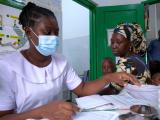Jan 12, 2011 (CIDRAP News) Warning that the spread of artemisinin-resistant parasites threatens the world's most potent tool for fighting malaria, the World Health Organization (WHO) today released a new plan for containment.
Developed with the Roll Back Malaria Partnership, the plan is designed to prevent resistance to artemisinin, the cornerstone of artemisinin-based combination therapies (ACTs) used to treat falciparum malaria, the most deadly form of the disease. In a press release today, the WHO said the drug strategy is a key reason malaria cases have dropped by 50% in 43 countries over the past decade.
The WHO published an 88-page report that includes the five-step plan on its Web site today.
Resistance to artemisinin was confirmed at the Cambodia-Thailand border in 2009, and suspected areas have been identified in the Greater Mekong region but have not been confirmed yet.
WHO Director-General Dr Margaret Chan, in comments today during the launch of the plan in Geneva, said over the past several decades global health officials have lost one front-line antimalaria drug after another because of the development of resistance.
"Today, in launching this global plan, WHO, together with Roll Back Malaria partners, is attempting to break this historical pattern," Chan said. "We are calling on the international community to take advantage of an unprecedented window of opportunity."
She said the timing of the containment push is ideal, because researchers have recently learned more about drug resistance mechanisms and monitoring of therapy efficacy is at an all-time high.
"Never before have the first subtle changes in parasite sensitivity been detected so early. Never before have the tools and strategies been in place to attempt to stop the emergence and spread of drug resistance at its source," Chan said.
However, she warned that while major efforts are under way to develop new classes of antimalarials, no replacements for ACTs are on the immediate horizon.
Chan said the resistance-containment strategy doesn't dilute current disease fighting efforts, but builds on them.
The plan's steps include:
- Fully funded and implemented malaria controls, with stepped-up efforts in areas where artemisinin resistance has been detected
- Increased surveillance for artemisinin resistance; the WHO estimates that only 31 of 75 countries routinely test ACT efficacy
- Improved access to malaria diagnostic testing andbetter-targeted treatment to avoid unnecessary use of ACTs
- Investments in artemisinin resistance research, especially for developing faster tests to detect resistance and new classes of antimalaria drugs
- Better mobilization and coordination of disease response
The plan's recommendations vary according to three different tiers that take into account the perceived threat of artemisinin resistance and degrees of intensity and resources. The section on increased prevention efforts, for example, addresses the movement of populations within malaria-endemic areas, which is thought to be a contributor to the spread of artemisinin resistance.
The containment plan was developed by the WHO's Global Malaria Program, which consulted with more than 100 experts from the Roll Back Malaria Partnership. The Bill and Melinda Gates foundation funded the plan.
See also:
Jan 12 WHO press release
Jan 12 WHO director-general statement





















